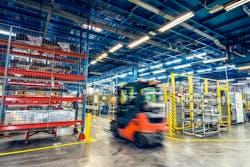Automation and the Supply Chain
Supply chain and production operations exist in a world where they are inextricably linked yet often function quite separately. And there are few places where this is more evident than in automation technologies. I say this because, most discussions of supply chains focus on transportation logistics and tracking of shipments; but how do the supply chain technologies that support these functions affect production operations? This connection is not so often explored.
To find out more about this, we connected with Matt Ruth, president of Avanceon, for a recent episode of the “Automation World Gets Your Questions Answered” podcast series. Avanceon is a system integration and engineering services company focused on industrial automation systems ranging from manufacturing execution systems and analytics to industrial Internet of Things projects, as well as delivery of automation technologies as a service.
See it Live at PACK EXPO Connects Nov. 9-13: Level-Up your Automation with Integrated Handling Devices & Robot Ready Solutions, by Shuttleworth, LLC. Preview the Showroom Here.
Ruth began our conversation by noting that Amazon and Walmart are very publicly tackling the last mile supply chain delivery issues with drones and different kinds of fleets. In turn, warehouse and inventory levels are reduced as things ship more just in time. “So there's a natural progression upstream into the operational piece as a next next step in efficiency,” Ruth said. “And we're seeing planning and operations that need to be functioning in a more predictive manner in order to anticipate and meet that just-in-time demand, but without having to create too much inventory of finished goods.”
To address this with automation technologies, Ruth noted that one of the most important things is having bi-directional data flow from the ERP (enterprise resources planning) system to the manufacturing systems. “Oftentimes a supply chain or ERP system pushes information down to the plant, but it doesn't receive a lot of information back. This allows operations to execute against the ERP but doesn't do a lot to improve the status of the information or understanding of people using the system to really know how things are progressing and make better decisions in real time. There's certainly detailed information that doesn't belong in the ERP, like the pressure of a certain vessel at a certain time, but there’s a lot of missed opportunity by not automating the collection back or not having any or very little production information.”
Another key consideration Ruth mentioned is data integration. Though this may seem obvious amid the current interest in industrial data analytics, Ruth said it's important to make sure that those manufacturing data sets are able to be combined with other business information for analysis. “This means making sure that data structures and definitions are readily combinable with your existing data sets. So a lot of the key indexes around how to associate things has to be a consideration from an ERP and manufacturing execution standpoint.”
Explaining how this can or should affect decisions around production automation technologies, such as controllers, HMI, and SCADA systems, Ruth said he subscribes to Ashby's Law of Requisite Variety. This law states that “in any given physical system, the part of the system with the greatest flexibility will control the system. That concept should be applied in all supply chains (and associated production systems) to the point that is realistic. But it's not going to be in the normal scope of a capital project approach. In many cases, it's going to require really looking at your approach to automation at a fundamental level, and measuring that across multiple projects to show improvement in value. The winning manufacturers will boost their adaptability with automation information and data analysis.”
See it Live at PACK EXPO Connects Nov. 9-13: Increase flexibility and efficiency with a fully autonomous and collaborative mobile system, by Omron. Preview the Showroom Here.
For manufacturers to successfully achieve this on an ongoing basis, Ruth says companies will likely benefit by leveraging the expertise of a partner they can rely on to “examine the options, recommend a path, and work with their technologies. This is important because it's not going to be a one shot fits all kind of integration. It’s going to require a bit of evolving back and forth as things change to manage the change that's coming.”
Ruth cautioned that, even with this approach, it’s not a good idea to apply too much change too quickly. The rate of change has to be something you're comfortable with while maintaining a “deep bench of options” for support. This will be necessary because continuously confronting coming changes means you’ll need to be able to “touch and tweak things often to live in this new normal, because I think we're walking into something we haven't seen before. And we're not completely prepared to abandon the old ways of how we did things. And that change will be a challenge.”


